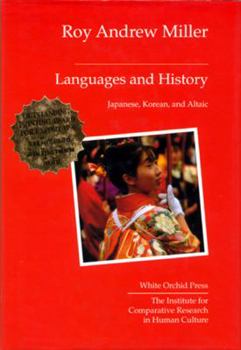Languages and History: Japanese
Summarizing what is known of the history and prehistory of Korean and Japanese, a problem that necessarily involves their possible genetic relationship to the Altaic (Turkic, Mongiol, Tungus)... This description may be from another edition of this product.
Format:Hardcover
Language:English
ISBN:9748299694
ISBN13:9789748299693
Release Date:July 2006
Publisher:Orchid Press
Length:230 Pages
Weight:1.05 lbs.
Dimensions:0.8" x 5.7" x 8.7"
Customer Reviews
1 rating
Fascinating introduction to the study of languages
Published by Thriftbooks.com User , 19 years ago
Having lived in the Far East for the last 16 years, I was intrigued by Prof. Miller's title, especially his sub-title: Japanese, Korean, and Altaic. During my five years in Japan and my three years in Korea, many people from all walks of life were horrified by my suggestion that Japanese and Korean might be related to each other. Most people I talked to in both countries consider their language to be unique in more than one way, although both languages were heavily influenced by Chinese, especially the writing system (Chinese characters, known as "han-zi" in mainland China, "han-ja" in Korea, and "kan-ji" in Japan). In both Japanese and Korean, many words that we call nouns and verbs were originally taken from Chinese. Over time, the pronunciations have diverged, as we can see above from the respective names for Chinese characters in the three countries. In addition, Japanese and Korean sentences have a remarkable "grammatical" similarity, using postpositions (instead of prepositions) of similar meaning and spelling in many of the same positions in the sentence. Most people cannot help but accept these basic similarities, but they quickly reject the notion that the two languages are "sisters" or even remote cousins. This is the background I brought to Prof. Miller's book, which not only suggests the two languages are related to each other but posits a connection to a larger language family, Altaic. Prof. Miller brings to this study a background that stretches from Tibetan to Chinese to Japanese and Korean. However, instead of embracing the connectedness of the languages based on the syntactic features (sentence structure), he holds that the sound systems of Japanese and Korean are related to an older Altaic. This is perhaps his most controversial claim. This argument makes for a fascinating introduction to the study of languages. In his opening chapter he sets out a series of working definitions of comparative and historical linguistics, and shows how these can be applied to any language family. He also notes that most of the objections to proposals of an Altaic family come from those who are more expert in Indo-European, which includes languages as different as English, Greek, and Hindi, but which are "well attested" by many ancient written records. The trail of written words is harder to follow in Altaic, a fact which Prof. Miller meets head on in his second chapter. In the third, he explains the concepts of Altaic, arguing that any reconstruction naturally starts from certain assumptions. He then goes on to show, with copious examples, how Japanese and Korean have a relationship with the other members of the Altaic family, which some scholars say includes Turkish, Tungusic, Mongolian, Manchu, and others. Next, Prof. Miller demonstrates those features of Altaic that he believes are still evident in Japanese and Korean. One of the most frequent complaints against his theory is that many of the features common to Japanese




